If you enjoy making a chili pepper salsa or you prefer adding chili peppers to your regular dishes, you might want to try growing them yourself. Growing your peppers at home is convenient and economical.
You might have come across pepper varieties like jalapeno, cayenne, and habanero, but there are more varieties that are easy to grow at home.
If this is your first pepper growing project, you’ve landed in the right place. Read on to learn more about the different types of chili peppers you can grow at home and some essential tips to help you succeed in your gardening project.
Table of Contents
Types of Peppers to Grow
Did you know that there’s a pepper for every mood and taste? Chili peppers have been hybridized, which means you can now find them in a variety of heat levels, sizes, colors, and shapes.
Here are the popular types of chili peppers to grow at home.

1. Cayenne Pepper
Cayenne peppers are thin and long. They have a bright-red color and pack a spicy hit. These chili peppers can be used in powdered, dried, or fresh forms.
The cayenne pepper is also known as the red pepper or the bird pepper. Despite the fact that cayenne peppers share some similarities with Jalapeno peppers, cayenne peppers are hotter.
The plant grows about two to four feet tall. Immature cayenne pods are green, but they turn red once they’re mature and ready for harvest.
2. Habanero Pepper
The habanero pepper is a maintenance-free pepper variety that you can grow at home. Habanero peppers come in orange, red, brown, and yellow colors.
Despite being one of the hottest peppers, habanero is a warm, seasoned pepper that you can grow in containers or pots. It tends to be bushy and compact, which makes it ideal for small gardens and balconies.
Note that habanero peppers are available in different varieties, but the snow-white variety is one of the easiest to maintain and is the most productive.
You can freeze your habanero peppers and use them to make sauces.
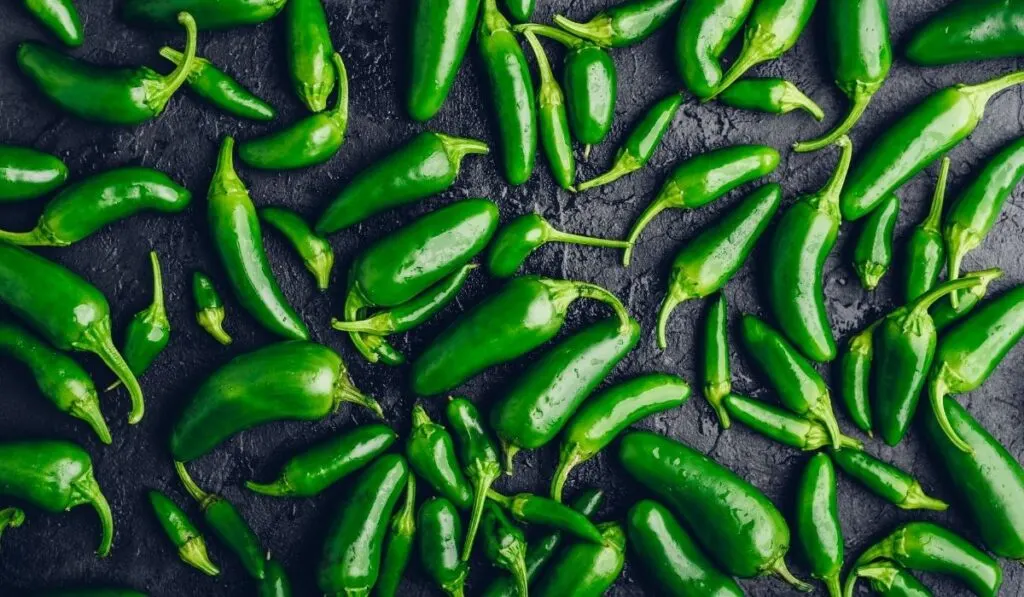
3. Jalapeño Pepper
Jalapeños are a classic and have a unique flavor. Although they are spicy, they are not too hot.
These spicy peppers are low maintenance and grow two to three feet tall. Jalapeños are ready for harvest in 75 days, which makes them ideal for northern gardeners.
You can use Jalapeño peppers in salsa, salads, and most Mexican foods.
4. Serrano Pepper
The Serrano pepper has its origin in Mexico and closely resembles the Jalapeño pepper in appearance. However, the Serrano pepper is much hotter and smaller than the Jalapeño.
This pepper can be red, brown, orange, yellow, and sometimes green.
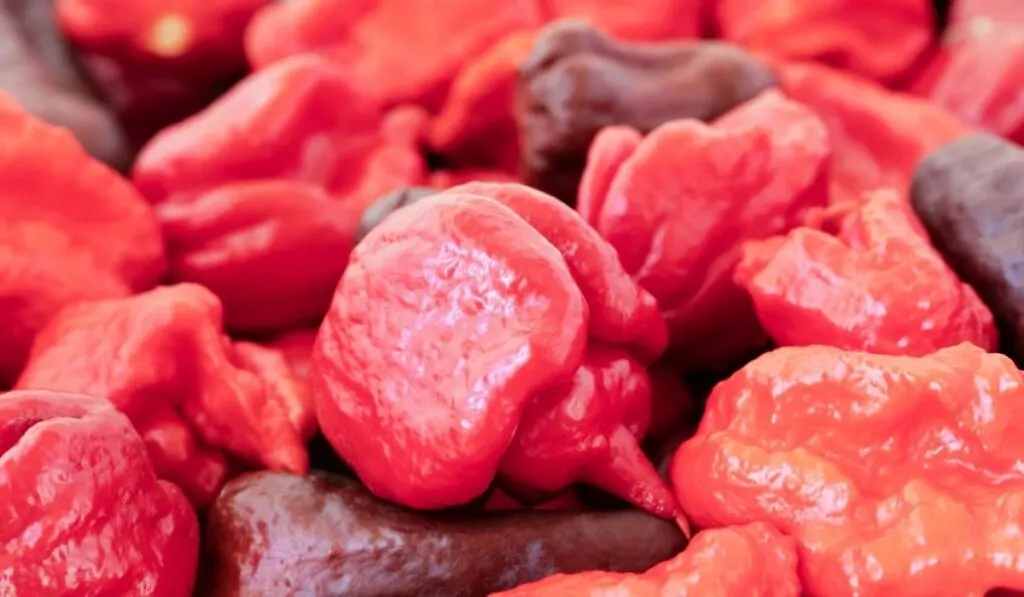
5. Carolina Reaper
Carolina Reapers are one of the hottest peppers with 1,400,000-2,200,000 Scoville heat units.
This pepper is a cross of Red Habanero and a Pakistani Naga. Unlike other popular peppers that are thin and tall in appearance, the Carolina Reaper is small and shaped like a scorpion tail.
6. Poblano
A poblano pepper is dark green and can sometimes ripen to a blackish color.
In Mexico, they refer to the peppers as “ancho” when dried and “poblano” when fresh. Poblanos are easy to grow and produce a lot of peppers.
The poblano pepper’s unique, mildly sweet flavor is the reason it’s used for chiles rellenos and most Mexican mole sauces.
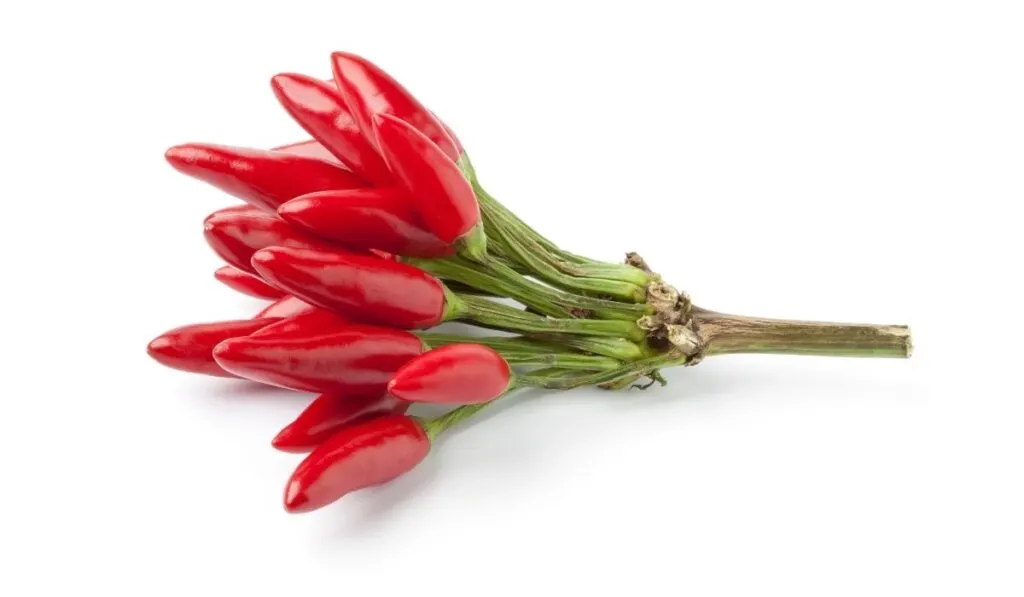
7. Tabasco
Tabasco peppers are shiny, small red peppers that can be grown in a pot or garden. The pepper plants grow straight up and change color as they ripen. When young, Tabasco peppers are yellow, then they transition to orange before turning to a red shade.
Tabasco peppers take up to 100 days to reach maturity.
Tabasco is also used in hot sauces. Its medium heat level makes it perfect for infusing vinegar.
8. Siling Labuyo
Siling Labuyo peppers are the smallest chili pepper variety in the world. The pepper has elongated but pointy tips, and the plant has small leaves.
Unlike other chilies that grow pointing downwards, Siling Labuyo peppers grow pointing upwards.
Although it shares some similarities with Thai chilies, Siling Labuyo is hotter and shorter than Thai peppers.
Most Philippine cuisines use Siling labuyo leaves and fruits to add flavor and a bit of heat.
9. Thai Chili Pepper
Also referred to as bird’s eye chili, the Thai chili pepper is originally from Mexico. It’s common in South and Central America but grows mostly in South Asia.
The plant grows up to six feet tall and has fruits that are an inch long. Thai peppers are green but ripen to a bright red color. Although the peppers are tiny, they are very hot and a popular ingredient in most Asian dishes.
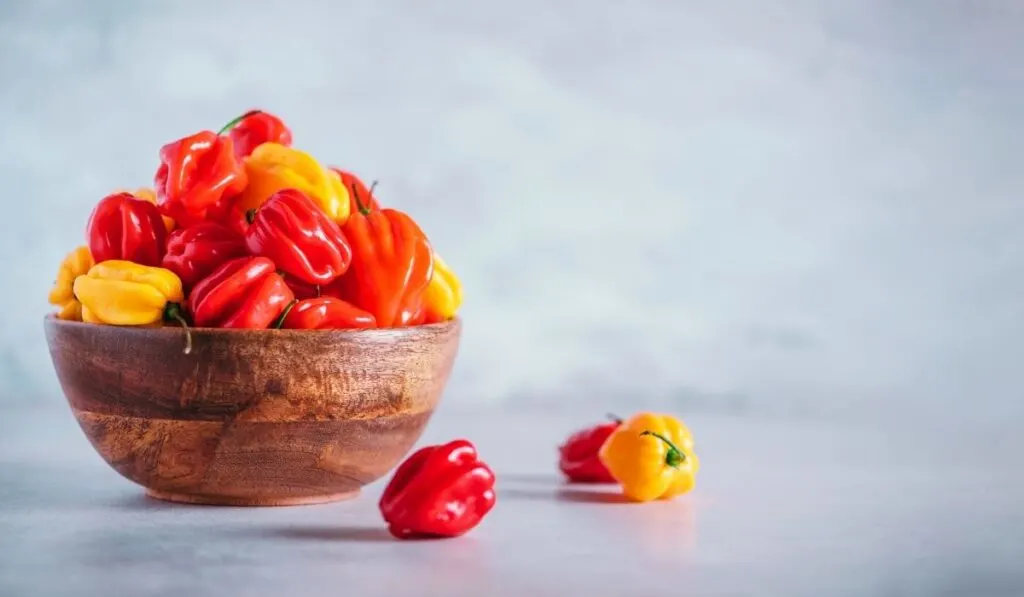
10. Scotch Bonnet
Scotch Bonnet peppers look similar to habaneros, but they are short and have a hat-like shape.
You can grow Scotch bonnet plants in containers, but you should note that they are a slow-growing variety. You should start the seeds early if you want mature peppers in time.
11. Anaheim Pepper
The Anaheim pepper has green fruits that turn maroon when ripe.
An Anaheim pepper plant can grow up to 15 feet tall. This perennial plant can produce fruit for three years and is one of the easiest to grow plants when well maintained.
Anaheim peppers have a mild flavor and work best for cooking and stuffing.
12. Pepperoncini
Pepperoncini is a favorite Italian pepper variety that you can plant in your garden. The pepper grows up to six inches and has a light green color. However, if pepperoncini peppers stay on the plant longer, they turn a bright red color.
This pepper variety is slightly spicy and has a sweet flavor. You can use it in your salads or pair it with your sandwiches.
13. Datil Pepper
The Datil pepper is a famous St. Augustine pepper variety known for its sweet yet spicy flavor.
An immature Datil pepper has a green color that turns golden yellow when ready for harvest. Additionally, this pepper variety shares a similar heat index with habanero—the only difference is its fruity taste.
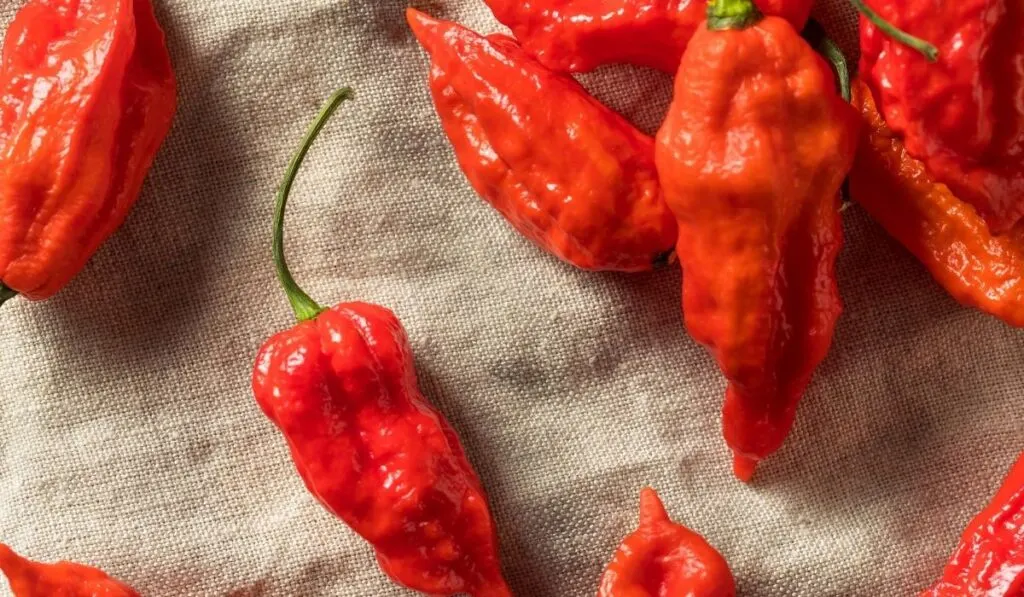
14. Bhut Jolokia
The Bhut Jolokia pepper is a crossbreed of Capsicum frutescens and Capsicum chinense. It’s also referred to as a ghost chili pepper or a red naha chili and is ranked as the third hottest pepper in the world.
You can use this pepper in its dried or fresh form.
15. Hungarian Yellow Wax
Hungarian yellow wax peppers have medium-thick flesh and turn red at full maturity. They grow up to seven inches long. These peppers produce fruit for weeks and grow well in cool regions.
Hungarian yellow wax peppers are ideal for canning and pickling as they maintain their crunchiness and hold their firmness. Their size also makes them ideal for stuffing.
16. Bulgarian Carrot Peppers
Bulgarian carrot peppers adapt well to a cool climate. You can grow them in containers.
They are also very productive despite the plant’s small size.
17. Cuban Peppers
Cuban peppers or Cubanelle peppers are a mild variety of chili peppers. You can plant them in a balcony garden or yard.
18. Black Panther Pepper
The Black Panther pepper is a cross between Pimenta da neyde peppers and bhut jolokia peppers.
The Black Panther pepper starts as black and ripens to a bright orange or red, depending on the variety. This super spicy pepper is common in most Chinese dishes.
19. Habanada Pepper
Habanada pepper has the habanero’s flavor without any heat. Its distinctive feature is its wrinkled texture and bright orange-red color.
You can easily grow the habanada pepper in your garden and spice your meals up with this unique pepper.

Tips For Growing Chili Peppers at Home
Growing chili peppers isn’t complicated once you choose the variety to plant and understand a few tips. Here are some pointers to get you a productive harvest.
Start the Seeds Early
Avoid sowing seeds in the garden, and instead, grow them indoors for 12 weeks before transferring them to your garden. Ensure you plant the seeds in a warm environment. You need a soil temperature of 80°F to germinate the seeds. Ensure the seedlings are moist in the early stage.
A 12-inch pot is big enough to grow a small pepper plant to maturity, while an 18-inch pot will work for bigger chilies. The pots should have enough drainage.
Get the Right Potting Soil
Getting the right potting soil is essential for a healthy harvest. Choose fluffy, light soil. The soil should allow enough oxygen to the root zone and reduce any over-watering issues.
A soil pH of 5.9-6.5 is recommended, as peppers thrive in slightly acidic soil. Some people will add beneficial bacteria and organic fertilizer to their soil. Check if the soil you’re buying has these qualities.
Know When to Transplant Pepper Plants
Transplant the pepper plants when the soil is at least 65°F and nighttime temperatures stay above 50°F.
Make sure the soil is well-drained and the planting area is in full sun. You can add bonemeal and compost before planting to help with germination. A root-promoting fertilizer can also be used to encourage root growth.
Add mulch to prevent weeds from sprouting and taking up all the nutrients.
However, you need to be careful to avoid exposing the peppers to too much sunlight, as the fruit may get sunburned. Use a cloth to protect your pepper plants from direct sun.
Alternatively, you can plant peppers between rows of tall pole beans or tomatoes. Ensure that the spacing is 12-18 inches, but this will depend on the pepper variety you plant.

Avoid Overwatering the Plants
While it’s tempting to continuously water your pepper plants, overdoing it can flood the roots. Additionally, it can also lead to stunted growth and encourage diseases.
The soil should allow proper drainage. You can also add mulch to prevent water evaporation. You should ensure that the soil is just damp.
Provide Support
Support your pepper plant by using cages or staking. That’s because when the plant grows and fruit sets, strong winds can break the stems.
Harvesting Peppers
Peppers are mature 10-12 weeks after transplanting. Some varieties might continue bearing fruit for months.
Peppers are ready for harvest when they turn from green to yellow, brown, or red. Once mature, peppers don’t change colors and won’t grow in size.
Check that the fruit pops off without a struggle. It should make a crisp snap when harvested.
Storing Peppers
Avoid washing your peppers, and instead store them unwashed in a ziplock bag in your fridge. Ensure that you sort out any rotting peppers to avoid spoiling the whole batch.
Final Thoughts
Peppers add a unique flavor to your ordinary cooking. While you might get peppers at the local store or grocery, it’s easier and more economical to grow them in your garden or balcony. You can opt for starter plants or grow seeds indoors before you transplant them into your garden.
Hopefully, with our comprehensive list, you now have an idea of what variety to plant and have some tips on how to grow healthy and productive chili peppers.
Sources
- https://morningchores.com/best-pepper-varieties/
- https://extension.umn.edu/vegetables/growing-peppers
- https://gardeningtips.in/pepper-varieties-to-grow-at-home-chilli-a-full-guide
- https://www.edenbrothers.com/store/blog/8-essential-peppers-for-summer-gardens/
- https://www.hortzone.com/blog/types-of-pepper-plants/
- https://www.canna-uk.com/chilli_pepper_grow_it_yourself
